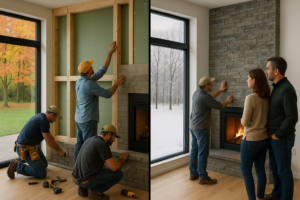w
You’re likely picturing your beautiful new kitchen or bath—sleek cabinets, modern tile, that feeling of transformation. But the real magic of remodeling doesn’t happen in 30 minutes like it does on HGTV. In fact, relying on those shows for a sense of timing can set you up for major disappointment.
This guide strips away the fantasy to show you the real timelines, real risks, and real planning steps that smart homeowners use to keep their remodels moving. We’ll cover:
- How long typical projects really take
- What causes delays (and how to avoid them)
- A complete case study of a premium kitchen remodel
- Labor-hour breakdowns by project type
- A rundown of true-to-life remodeling surprises
- Why planning and sequence matter more than speed
- And how to leverage experts to stay on schedule
The Myth of the Fast Remodel
TV shows edit out the boring, time-consuming, and bureaucratic parts of remodeling. They don’t show you the permit backlog, the two-week cabinet delay, or the contractor no-show because his last job ran long.
A standard kitchen remodel doesn’t take three days. It takes 6 to 12 weeks. According to a 2022 Houzz survey, that’s the national average for a full kitchen update. Add a room? You’re looking at 3 to 6 months. A whole-home renovation? Expect 6 to 12 months, especially if structural changes or permits are involved.
Related: How to Manage Your Remodel Like a Pro »
7 Factors That Drag Out Your Timeline
1. Scope of Work
A cosmetic bathroom facelift can be done in two weeks. A down-to-the-studs kitchen overhaul with plumbing, electrical, flooring, cabinets, and appliances? That’s a 10–14 week job—minimum.
2. Design Finalization
Change orders are one of the top causes of delays. Lock in your layout, finishes, and materials before demo. Use a remodeling goals checklist to clarify what you want—and avoid mid-project chaos.
3. Permit Approvals
In fast-growing cities like Austin, TX, zoning and site plan reviews can add 4–6 weeks to your schedule. In San Francisco, building permits for remodels routinely take 45–60+ days, especially if your plans trigger historic review or code compliance.
4. Contractor Availability
Top-tier contractors are rarely available on short notice. In post-disaster areas (like Louisiana after Hurricane Ida), many were booked out for 6–9 months. Some homeowners hired out-of-state crews and paid for housing just to rebuild on time.
5. Material Lead Times
During COVID, product delays wreaked havoc. HVAC systems were backordered 3–6 months, windows took 12–16 weeks, and some GE appliances disappeared from warehouses altogether.
6. Weather
Remodels involving roofing, siding, foundations, or additions are at the mercy of the sky. A rainy week can kill your framing schedule.
7. The Unexpected
Open a wall and find mold. Dig a trench and find a century-old gas pipe. Discover your home is under historic protection after demo starts.
We’ll dig deeper into some of these below.
Typical Remodel Timelines (and Man-Hours)
| Project | Duration | Labor Hours | Typical Cost |
|---|---|---|---|
| Small Bathroom | 2–4 weeks | 200–400 hrs | $5,000–$10,000 |
| Kitchen Remodel | 6–12 weeks | 300–600 hrs | $20,000–$75,000+ |
| Room Addition | 3–6 months | 800–1,200 hrs | $30,000–$80,000 |
| Whole-Home Renovation | 6–12 months | 2,000–4,000+ hrs | $100,000+ |
(Source: Buildertrend, NAHB, Fixr)
Real-World Case Study: Premium Kitchen Remodel in Portland, OR
A homeowner in Portland undertook a $75,000 full kitchen renovation that included:
- Layout changes (moving plumbing + electrical)
- Heated tile floors
- Semi-custom cabinets
- Quartz counters
- Upgraded lighting and appliances
Timeline Breakdown
| Week | Phase |
|---|---|
| 1 | Demolition & haul-off |
| 2 | Reframing & subfloor leveling |
| 3–4 | Plumbing & electrical rough-in |
| 5 | City inspection delay (added 4 days) |
| 6 | Lighting re-spec + HVAC ducting |
| 7 | Drywall & taping |
| 8 | Tile flooring |
| 9–11 | Cabinet delivery (delayed 3 weeks) |
| 12 | Appliance install, countertops |
| 13 | Punch list corrections & walkthrough |
Total Duration: 13 weeks (planned for 10)
10 True Remodeling Surprises That Caused Serious Delays
These real examples (from media, forums, and lawsuits) show how things can go wrong—fast:
- Historic Protection Triggered – Pasadena homeowner had to pause siding work for 6 weeks while a historic board reviewed plans.
- Trenching Uncovers Gas Line – Tennessee project found an unmarked 1920s main line that halted progress for 10 days.
- Property Line Dispute – California addition encroached 18 inches on neighbor’s land. Redesign + legal = 2-month delay.
- Unpermitted Garage Conversion – Phoenix inspectors demanded retroactive approval, halting work for 4 weeks.
- Asbestos in Duct Wrap – Denver job halted for hazmat removal.
- Mold Behind Cabinets – Seattle condo required $8,000 in remediation.
- Collapsed Septic Field – Georgia deck rebuild needed structural engineer redesign.
- Inherited Title Issues – Detroit family couldn’t start remodel until probate court resolved ownership.
- Zoning Litigation – LA homeowners sued over shared driveway easement, delaying permit by 3 months.
- Termite Damage in Joists – Florida bath remodel expanded into floor rebuild.
Related: Top Remodeling Mistakes That Can Cost You »
How to Build a Realistic Remodel Timeline
1. Break It Into Phases
You can’t manage what you can’t see. Break your project into functional phases. For most remodels, the phases include:
- Design & Planning
- Permitting
- Demolition
- Framing & Structural Work
- Rough-ins (Electrical, Plumbing, HVAC)
- Inspections
- Drywall & Texture
- Flooring & Tile
- Cabinetry & Millwork
- Finish Electrical & Plumbing
- Paint & Final Touches
- Punch List & Closeout
2. Pad Your Timeline
Even well-run remodels have hiccups. A smart rule: add 10–20% buffer to every phase. For example, if your kitchen is projected to take 10 weeks, budget for 11–12. You may finish early, but if you don’t, you won’t be blindsided.
3. Lock Decisions Early
Cabinets, tile, fixtures, paint, appliances—every delay in making a decision creates ripple effects. Choose your finishes and materials before demolition starts. Don’t wait until the walls are open.
4. Sync With Contractor Schedules
Many delays happen not because of actual work time, but because subcontractors aren’t available when needed. For example, if your electrician finishes rough-in but your inspector can’t come for four days, your drywall team has to wait—and might book another job.
Related: Handle Contractor Delays and Excuses »
Why Planning Beats Panic Every Time
Lack of planning isn’t just inconvenient—it’s expensive.
A homeowner in Arizona had to pay $7,000 extra after re-ordering countertops because the original appliances didn’t fit. The reason? They hadn’t finalized appliance specs before framing. That decision set off a domino of costly change orders and delays.
Every hour you spend pre-planning saves days (and dollars) once demo begins. If you’re unsure how to do that, a remodel advisor can fill the gap.
The Role of a Remodel Advisor
A Trusted Remodel Advisor isn’t a designer. They’re a planning partner who acts like a general contractor’s strategist—before the hammer swings. They can:
- Review your plans and spot missing info
- Help you develop a timeline with realistic milestones
- Pre-vet contractors
- Flag delays before they happen
- Serve as a sounding board when things go sideways
A single advisory session (often $500–$700) can save thousands by preventing mid-project rework.
Final Recommendations
To keep your remodel on schedule, remember these fundamentals:
✅ Break your project into sequenced phases
✅ Pad your schedule by 10–20%
✅ Finalize selections before demolition
✅ Hold weekly progress check-ins
✅ Plan for inspections, not just work
✅ Expect delays—prepare for them
Remodeling is complex. But when it’s well-managed, it doesn’t have to be painful.
Suggested Next Reads (Internal Links)
- How to Hire a Remodeling Contractor »
- Splurge or Save? Remodel Budget Strategies »
- The Homeowner’s Guide to Remodeling Planning »
- Surviving a Remodel While Living in Your Home »
- The Most Common Hidden Remodeling Costs »
Closing Thoughts: The Remodel Clock Is Always Ticking
The number one reason homeowners get burned during a remodel isn’t cost—it’s time. Delays that stretch from weeks to months strain patience, finances, and sometimes even relationships.
But that doesn’t have to be your story.
Set realistic expectations. Prepare for surprises. Make decisions early. Know that speed is not the enemy—but poor planning is. The homeowners who succeed aren’t lucky—they’re informed, proactive, and well-prepared.
And when you’re armed with the right strategy and a detailed timeline?
You stop watching the clock—and start enjoying the transformation.








